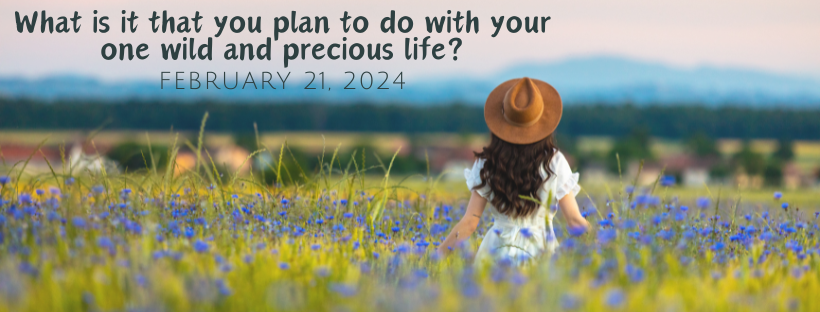


Dearly Beloved,
I was reminded recently that the context for Mary Oliver's question: "what is it that you plan to do with your one wild and precious life" is important.
Without the context, it can feel like a great sweeping question. And honestly, I think that's how I used it in last week's midweek. But Oliver has a clear answer.
Who made the world? Who made the swan, and the black bear? Who made the grasshopper? This grasshopper, I mean— the one who has flung herself out of the grass, the one who is eating sugar out of my hand, who is moving her jaws back and forth instead of up and down— who is gazing around with her enormous and complicated eyes. Now she lifts her pale forearms and thoroughly washes her face. Now she snaps her wings open, and floats away. I don't know exactly what a prayer is. I do know how to pay attention, how to fall down into the grass, how to kneel down in the grass, how to be idle and blessed, how to stroll through the fields, which is what I have been doing all day. Tell me, what else should I have done? Doesn't everything die at last, and too soon? Tell me, what is it you plan to do with your one wild and precious life?
The answer for Mary Oliver is to ask questions.
Who made the world?
It is to slow down and pay attention, not simply to the big question: "who made the grasshopper?" but to the very specific question: "This, grasshopper, I mean--"
Oliver moves quickly to bring herself and her reader from the meta/universal question right down to the very particular one. The one that attends to this moment. This grasshopper. And then Oliver observes: "the one that is eating sugar out of my hand, who is moving her jaws back and forth instead of up and down --"
Oliver suggests that this attention to the present moment, to the life right here, in her hand or floating away, is what prayer is all about.
Oliver's answer to the question: "what is it you plan to do with your one wild and precious life?" has to do with rest, expansiveness, play, and pleasure. To paraphrase, she writes: "I know how to pay attention, to kneel in the grass, to be idle and blessed, to stroll through the fields, which is what I have been doing all day." And this is what she does. This is what she plans to do with her one wild and precious life.
What would happen if we could give ourselves that expansiveness?
If we could gauge not the "success" or productivity of the day but its connectivity, our attention, the beauty of what we observe, our willingness to be present to ourselves and to the world (in its aching beauty and its devastating heartbreak) around us and to experience the holy in the midst of all of that.
Who made the world?
Who made the fly? This fly, I mean. The one buzzing in my office window.
I don't know exactly what a prayer is.
But I hope that I can learn to pay attention.
To pause. To rest. To be. To watch and to connect.
Dare I say, to be idle and blessed....
I pray the same for you.
With love and blessing,
Thandiwe
